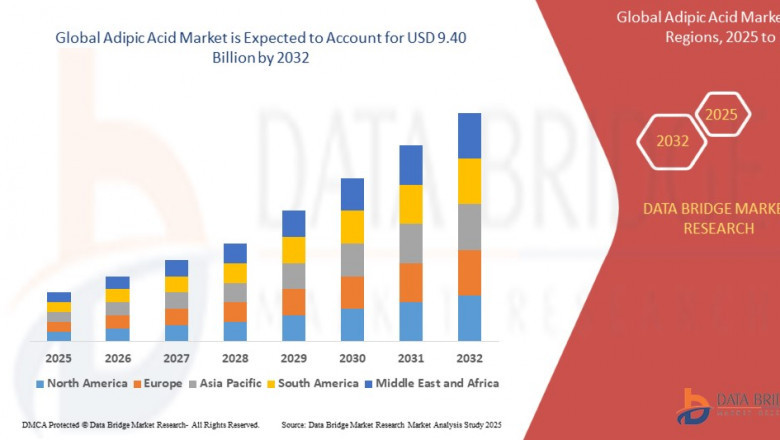views
Adipic Acid: An Essential Industrial Chemical
Introduction
Adipic acid is a vital industrial compound primarily used in the production of nylon-6,6, a polymer with extensive applications in textiles, plastics, and automotive components. As one of the most commercially significant dicarboxylic acids, adipic acid is essential for manufacturing polyurethanes, plasticizers, and food additives. However, its synthesis and use present both environmental challenges and economic opportunities. This article explores the production, properties, applications, and environmental impact of adipic acid, along with market trends and innovations in sustainable production.
Chemical Properties and Structure
Adipic acid (C6H10O4) is a white crystalline solid with the following characteristics:
-
Molecular formula: C6H10O4
-
Molar mass: 146.14 g/mol
-
Melting point: 151-154°C
-
Solubility: Soluble in water, alcohols, and acetone
-
pKa values: 4.41 and 5.41, indicating moderate acidity
Structurally, adipic acid consists of a six-carbon backbone with carboxyl (-COOH) functional groups at each end. This dicarboxylic nature makes it a crucial building block in polymer chemistry.
Production of Adipic Acid
Adipic acid is traditionally produced via the oxidation of cyclohexanol and cyclohexanone using nitric acid. This method, while efficient, generates nitrous oxide (N2O), a potent greenhouse gas. The main steps of conventional adipic acid synthesis include:
-
Oxidation of Cyclohexane: Cyclohexane is oxidized to a mixture of cyclohexanol and cyclohexanone.
-
Nitric Acid Oxidation: The mixture is then treated with nitric acid, yielding adipic acid and releasing nitrous oxide as a byproduct.
Applications of Adipic Acid
Adipic acid finds widespread applications across multiple industries:
1. Nylon-6,6 Production
The largest share of adipic acid production (around 85%) goes into making nylon-6,6. This high-strength polymer is used in:
-
Textiles and carpets
-
Engineering plastics
-
Automotive parts (e.g., air intake manifolds, radiator end tanks)
2. Polyurethane Industry
Adipic acid is a precursor to polyurethane foams and elastomers used in:
-
Furniture and mattresses
-
Automotive seat cushions
-
Insulation materials
3. Plasticizers
As a plasticizer, adipic acid enhances the flexibility and durability of PVC and other polymers, making it ideal for:
-
Wire and cable insulation
-
Coatings and adhesives
4. Food and Pharmaceutical Industry
Adipic acid is an FDA-approved food additive, commonly used as an acidity regulator in:
-
Soft drinks
-
Jellies and fruit juices
-
Baking powders
Environmental Impact
The conventional production of adipic acid has significant environmental concerns:
-
Greenhouse Gas Emissions: The process generates nitrous oxide, which has a global warming potential nearly 300 times that of CO2.
-
Waste Generation: Large quantities of waste and byproducts require proper disposal.
-
Energy-Intensive Process: Traditional methods require high energy input, increasing the carbon footprint.
To combat these issues, research is focusing on greener alternatives, including:
-
Bio-based production: Using genetically engineered microorganisms to produce adipic acid from renewable sources like glucose.
-
Electrochemical oxidation: A method that reduces nitrous oxide emissions.
-
Catalytic processes: Developing new catalysts to enhance efficiency and reduce waste.
Market Trends and Future Prospects
The global adipic acid market is expected to grow steadily, driven by:
-
Increasing Demand for Nylon: The automotive and textile industries are major consumers.
-
Sustainability Initiatives: Regulatory pressures are encouraging companies to adopt eco-friendly production methods.
-
Innovations in Green Chemistry: Advances in biotechnology and catalysis are paving the way for more sustainable adipic acid production.
Source:- https://www.databridgemarketresearch.com/reports/global-adipic-acid-market
Conclusion
Adipic acid remains a crucial industrial chemical with diverse applications in textiles, automotive, and food industries. However, its environmental impact necessitates sustainable innovations. Ongoing research into bio-based and catalytic production methods offers promising solutions for a greener future. As industries shift toward eco-friendly practices, the adipic acid market is set to evolve, balancing economic viability with environmental responsibility.
Browser trending reaports:-
Global Adipic Acid Market – Industry Trends and Forecast to 2029
https://www.databridgemarketresearch.com/reports/global-adipic-acid-market
Global Solid Organ Transplantation Market – Industry Trends and Forecast to 2029
https://www.databridgemarketresearch.com/reports/global-solid-organ-transplantation-market
Global Waste Heat Recovery Thermal System Market – Industry Trends and Forecast to 2029
Global Open Frame Industrial Display Market – Industry Trends and Forecast to 2029
https://www.databridgemarketresearch.com/reports/global-open-frame-industrial-display-market
Global Automotive Elastomer Market – Industry Trends and Forecast to 2029
https://www.databridgemarketresearch.com/reports/global-automotive-elastomer-market
Global Corn Meal Market – Industry Trends and Forecast to 2029
https://www.databridgemarketresearch.com/reports/global-corn-meal-market
Global Immune Health Supplements Market – Industry Trends and Forecast to 2029
https://www.databridgemarketresearch.com/reports/global-immune-health-supplements-market
Global Lignin Market – Industry Trends and Forecast to 2029
https://www.databridgemarketresearch.com/reports/global-lignin-market
Global Hydrocarbon Solvents Market – Industry Trends and Forecast to 2031
https://www.databridgemarketresearch.com/reports/global-hydrocarbon-solvents-market
Global Acetaminophen (Paracetamol) Market – Industry Trends and Forecast to 2030
https://www.databridgemarketresearch.com/reports/global-acetaminophen-paracetamol-market













Comments
0 comment